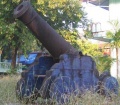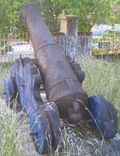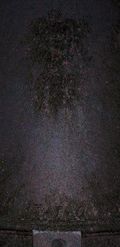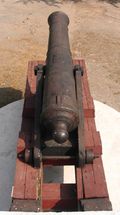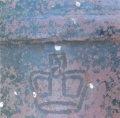British Guns in Burma
| This article describes some famous artillery pieces with connections to the era of the British in India. The information and images have been provided by Elizabeth Hancox, a FIBIS member with a special interest in artillery, and the Anglo-Burmese Library. |
This gun is in the museum at Moulmein, Burma.
- widths="250px"
-
Image courtesy of the Anglo-Burmese Library
-
Image courtesy of the Anglo-Burmese Library
-
Image courtesy of the Anglo-Burmese Library
This smooth-bore cast iron gun, dated 1826 and bearing the elaborate ‘Crown & P’ mark of George IV, signifying that the gun had passed proof in the Royal Navy yards as fit and ready for service, is of the Blomefield pattern, named after Thomas Blomefield, Inspector of Artillery at Woolwich between 1780 and 1822. It has the characteristic breeching loop above the button, typical of naval guns of this pattern, also carried by Nelson’s VICTORY at Trafalgar. The loop had a heavy duty hawser passed through it, lashing the gun to the ship to prevent too much unpredictable recoil demolishing the mast and occasionally demolishing members of the gun crew as well. Formerly masts were padded at the base using ‘soft substance’ but this was never satisfactory, especially in the case of very heavy cannon.
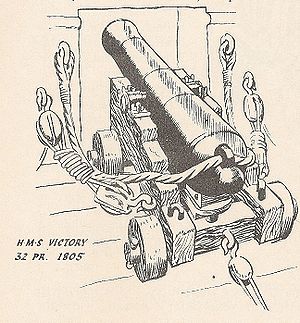
Below is a drawing and extract from ‘The story of the Gun’ Lt AW Wilson RA first published 1944:
‘The drawing shows a 32pr. on board the VICTORY. Compare it with any piece of 200 years before and notice the similarity. Elevation was still obtained by means of the quoin or wedge, while the only advance on checking recoil by means of ‘soft substance’ around the mast, seems to be that of anchoring the piece to the ship by a breeching passed through the eye of the cascable. The number in the detachments for these guns was decided by allowing one man for each 500lbs of metal. The 32-pounder weighed 32 cwt (3,584 lbs) and therefore had a crew of seven. It is interesting to consider that were we to use the same system today we should require a detachment of 70 for one of our modern heavy guns.’
The gun at Moulmein is marked as 17-1-0, indicating a weight of 17cwt 1 qtr and 0lbs. Which is a much lighter weight that might be expected for an approximately 9ft long, 32-pounder cannon. This is indicative of a carronade.
Carronades were a revolutionary concept in naval gunnery, known by the sailors as ‘Smashers’. They were first produced at the Carron Ironworks at Falkirk, Scotland, in 1770. They fired a 32lb. hollow shell filled with 500 musket balls. The idea was to approach enemy shipping from the rear and, aimed at the stern, the shell would explode on impact causing a shower of bullets to fly along the decks towards the bow, killing as many enemy crew and troops as possible. The ultimate 18th century naval anti=personnel weapon!
During the 2nd Burma War, Commodore Tarlton was in charge of the naval operations at the Battle of Martaban (on the opposite bank of the Salween River to Moulmein) and also at Pegu. His ship was HMS Fox. This ship was a vessel of 1,131 tons, built at Portsmouth in June 1821, re-fitted in September 1850, she was a 5th rate ship of the line, indicating a complement of 46 guns. On her quarterdeck she was armed with 10 32-pounder carronades, one of which corresponds exactly to the weight marked on the Moulmein piece.
Guns found at Mandalay Palace
The Pair of Guns at the Entrance
For the wind is in the palm trees, and the temple bells they say:
"Come you back, you British soldier; come you back to Mandalay!".
from 'MANDALAY' by Rudyard Kipling
- widths="330px"
-
Palace entrance gun 1
Image courtesy of the Anglo-Burmese Library -
Palace entrance gun 2
Image courtesy of the Anglo-Burmese Library
These two guns are similar but cast by different foundries. They are Royal Navy cast iron smooth bore muzzle-loading cannon, as are the pair at the exit, and they bear the Crown and 'P' signifying they have passed proof, that is to say been test fired, and they are stamped with the Royal Cipher of George ll (reigned 1727-1760). One gun has a weight of 57cwt 0qrs 8lbs (cwt = hundred weight = 112lbs; qrs = quarter = 28lbs). The other gun would seem to be of very similar weight. Both are 32-pounder demi-cannon of nine and a half feet.
- widths="150px"
-
Palace entrance gun 1 detail 1
Image courtesy of the Anglo-Burmese Library -
Palace entrance gun 1 detail 2
Image courtesy of the Anglo-Burmese Library -
Palace entrance gun 1 detail 3
Image courtesy of the Anglo-Burmese Library -
Palace entrance gun 2 detail
Image courtesy of the Anglo-Burmese Library
Palace entrance gun 1 was cast at the Waldron foundry near Heathfield in Sussex, at the time of John Harrison, Ironmaster. It is marked W on the trunnion which is the short iron protuberance each side which balances the cannon on the gun carriage enabling it to be tilted as necessary.
Palace entrance gun 2 was cast a short distance away at the Heathfield foundry by John Fuller (marked JF on the trunnion). This trunnion mark was used between 1722 and 1745.
Gun founders were a tight-knit community, often inter-related, and were in the habit of sub-contracting work to a neighbouring foundry if they were over-committed with orders. This may well have happened with these two cannon.
The question that we all want to know, of course, how did these two pairs of Royal Navy cannon find themselves guarding a Burmese potentate's palace in Mandalay ? Well, that will be another story .......... work in progress!
The Pair of Guns at the Exit
Gold is for the mistress, silver for the maid
Copper for the craftsman cunning at his trade.
"Good!" said the Baron, sitting in his hall,
"but Iron, Cold Iron, is master of them all."
from 'COLD IRON' by Rudyard Kipling
- widths="330px"
-
Palace exit gun 8009
Image courtesy of the Anglo-Burmese Library -
Palace exit gun 8012
Image courtesy of the Anglo-Burmese Library
These are the oldest Royal Navy guns seen. They are marked with the Rose & Crown insignia which was used by the Board of Ordnance from 1690 to 1725. The design of the crest varied slightly as the years progressed. The guns are marked respectively 8009 and 8012 and the marks on the buttons are L7 and S11. These last refer, I believe, to the guns' position on board ship, Larboard No.7 and Starboard No.11. The word Larboard was subsequently changed to Port to avoid confusion. The serial numbers are recorded in Col. Browne's Survey and refer to a date of 1695. From this survey it can be established that they are nine and a half foot 32-pounder demi-cannon, cast by Thomas Weston, Ironmaster of the Ashburnham forge near Battle, East Sussex, for HMS NEWARK. She was a Third Rate ship of the line mounting 76-80 guns of various weights.
- widths="150px"
-
Gun 8009 detail 1
Image courtesy of the Anglo-Burmese Library -
Gun 8009 detail 2
Image courtesy of the Anglo-Burmese Library -
Gun 8012 detail 1
Image courtesy of the Anglo-Burmese Library -
Gun 8012 detail 2
Image courtesy of the Anglo-Burmese Library
Each of these 32-pounders would be serviced by 14 men and a 'powder monkey' (a small boy who could easily run up and down ladders carrying bags of gunpowder from deep in the ship's hold). HMS NEWARK was refitted in 1717 and in 1745. At each refit, and possible alteration to the ship's hull, it was usual to remove and assess which guns would still be needed. Those surplus to requirements, but still in good condition, would be transferred to the ordnance stores and placed on another ship as needed. Well founded cannon, if used with the correct amount of powder, single-shotted and not fired at extreme elevation, could be expected to last 1000 firings and a few were recorded as lasting for 3000 before becoming worn out and useless.
Pair of Guns at Maymyo Forest Department
- widths="330px"
-
Cannon at Maymyo Forestry Dept view 1
Image courtesy of the Anglo-Burmese Library -
Cannon at Maymyo Forestry view 2
Image courtesy of the Anglo-Burmese Library
These neat bronze guns, cast at the East India Company’s gun foundry at Cossipore, in the district known as the 24 Purganas, not far north of Calcutta on the way to Barrackpore. They were cast by by Capt A Broome of the Bengal Artillery who was in charge of the foundry from 1846 to 1864. This pair of guns were cast in 1851, just at the beginning of the best period of his production, and would appear to be 9-pounders. They were undoubtedly cast for a small vessel of some sort, probably intended for mounting on the bow. These two most unusual guns have breeching loops - but underneath the buttons, which I have not seen before.
- widths="150px"
-
Breeching loop detail
Image courtesy of the Anglo-Burmese Library -
Button detail
Image courtesy of the Anglo-Burmese Library -
Casting date and place detail
Image courtesy of the Anglo-Burmese Library -
Date detail
Image courtesy of the Anglo-Burmese Library -
Founder and date detail
Image courtesy of the Anglo-Burmese Library
The 3rd Burma War was prosecuted using large gun vessels such as “IRRAWADDY” and “KATHLEEN”, barges, flats, small pleasure craft and the like, in order to move troops and equipment up river to complete the subjugation of Upper Burma. All these vessels carried guns of various calibres. “IRRAWADDY” did carry a 64-pounder carronade amongst other guns. One of the barges “WHITE SWAN”, is noted as being “bristling with guns”
Apparently the Maymyo cannon have been placed on carriages suitable for use on the railway.
The Mandalay Monster
- widths="330px"
-
Mandalay Monster
Image courtesy of the Anglo-Burmese Library -
Mandalay Monster detail
Image courtesy of the Anglo-Burmese Library
Without actual measurements it is difficult to calculate the poundage. Also we do not have a photo of the trunnion ends, which appear to be decorated. However this is clearly a cast iron gun. It is very roughly made native construction but with some input and advice from Europeans. I would imagine it is early 18th century. The interior of the muzzle is very interesting and the flaring appears to be decorative. The exterior of the muzzle seems to be simulated brickwork. It is unlike any other gun I have ever seen.
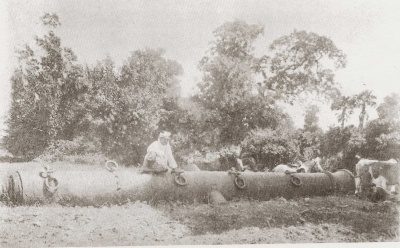
There is an account in the British Library IOLR- L/MIL/17/19/32/2; supplement to the History of the Third Burmese War 1885-1886. The Diary of Lt Henry Ernest Stanton, as follows:
"20th November 1885 AMARAPURA- Major Hewitt commanding Officer 1st Royal Artillery, with 100 men on reconnaissance. He found in the Old Palace enclosure 3 guns, 2 were broken and overgrown with grass. The third, of the same description as the others, was 30ft long 12” calibre and made of rings of iron, roughly welded together. The Burmese say these guns came from Arakan. They were left as they lay, being quite unserviceable.”
Another description comes from George W. Bird in his ‘Wanderings in Burma’ published in 1896. George Bird spent 20 years with the Education Department and his book, a series of different itineraries, is, in effect, the first guide book to Burma.
In ’Route XIV- Amarapura' pages 305 and 306…….
"Lying alongside of and half buried by the ruins of the campanile and the surrounding jungle, lies the enormous cannon captured from the Arakanese in 1784.
The principal dimensions taken by the writer from actual measurements are:- Exterior length 28ft 1in. Circumference below breech 9ft ins. At mouth 8ft 2ins. Calibre 11½"
The cannon is constructed of iron bars about 1½” square which run along the entire length. Round these bars lateral hoops or rings of similar bars are shrunk on and the whole welded together. Five pairs of enormous rings are welded onto the upper surface, apparently for the purposes of transport by means of long poles carried on men’s shoulders.
Lying in close proximity is another lesser size and of the same construction, and a few yards to the east buried in rubbish and jungle is a third, about 7 or 8 ft long with a calibre of about 16” which, from its chubby appearance, was probably a mortar for throwing shells or bombs."
These two descriptions are clearly of the same cannon although the measurements vary slightly. The photograph in George Bird’s book was taken by the famous war photographer Felice Beato who had finally settled in Mandalay and opened a curio shop. Finally the cannon was moved to the grounds of Mandalay Palace where the modern photograph was taken by Mr Mark Steevens.
The “ Monster” might have been a coastal defence weapon, especially if it came originally from the Arakan.
